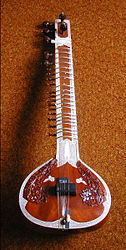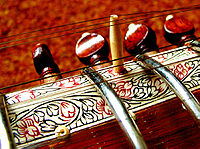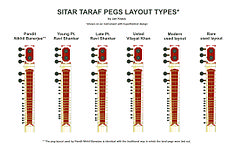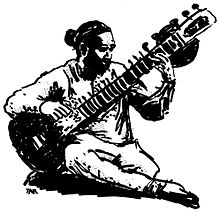- Sitar
-
{ It {for|the Persian Classical musical instrument|Setar}}
Sitar 
Miraj sitarString instrument Other names sitar Classification - Necked bowl lutes
- String instruments
Hornbostel–Sachs classification 321.321-6
(Composite chordophone sounded with a plectrum)Developed 13th century Related instruments - Surbahar
- Rudra veena
- Saraswati veena
- Chitra veena
- Vichitra veena
- Sarod
- Sursingar
- Tambura
The sitar (
 /ˈsɪtɑr/ or /sɪˈtɑr/; Hindi: सितार, Bengali: সেতার, Urdu: ستار, Persian: سیتار ; Hindustani pronunciation: [ˈsɪ.t̪aːr]) is a plucked stringed instrument predominantly used in Hindustani classical music, where it has been ubiquitous since the Middle Ages. It derives its resonance from sympathetic strings, a long hollow neck and a gourd resonating chamber.
/ˈsɪtɑr/ or /sɪˈtɑr/; Hindi: सितार, Bengali: সেতার, Urdu: ستار, Persian: سیتار ; Hindustani pronunciation: [ˈsɪ.t̪aːr]) is a plucked stringed instrument predominantly used in Hindustani classical music, where it has been ubiquitous since the Middle Ages. It derives its resonance from sympathetic strings, a long hollow neck and a gourd resonating chamber.Used throughout the Indian subcontinent, particularly in India, Pakistan, and Bangladesh, the sitar became known in the western world through the work of Pandit Ravi Shankar beginning in the late 1950s and early 1960s after The Kinks' top 10 single "See My Friends" featured a low tuned drone guitar which was widely mistaken to be the instrument[1]. The sitar saw further use in popular music after The Beatles featured the sitar in their compositions, namely "Norwegian Wood (This Bird Has Flown)" and "Within You Without You". Their use of the instrument came as a result of George Harrison taking lessons on how to play it from Shankar and Shambhu Das[2]. Shortly after, The Rolling Stones used a sitar in "Paint It, Black" and a brief fad began for using the instrument in pop songs.
Contents
Etymology and history
In his Bharatiya Sangeet Vadya Dr. Lalmani Misra traces its development from the tritantri veena through the nibaddh and anibaddh tamburas (so named after Rishi Tumbru), also called tanbur and later the jantra. Construction of the similar tanpura was described by Tansen. During the time of Moghul rule Persian lutes were played at court and may have provided a basis of the sitar. However, there is no physical evidence for the sitar until the time of the collapse of the Mughal Empire.
Mechanics
The sitar's curved frets are movable, allowing fine tuning, and raised so that sympathetic strings (tarb, also known as "taarif" or "tarafdaar") can run underneath them. A sitar can have 21, 22, or 23 strings, among them six or seven played strings which run over the frets: the Gandhaar-pancham sitar (used by Vilayat Khan and his disciples) has six playable strings, whereas the Kharaj-pancham sitar, used in the Maihar gharana, to which Pt. Ravi Shankar belongs, has seven. Three of these (or four on a Kharaj-pancham sitar), called the chikaari, simply provide a drone: the rest are used to play the melody, though the first string (baajtaar) is most used.
The instrument has two bridges; the large bridge (badaa goraa) for the playing and drone strings and the small bridge (chota goraa) for the sympathetic strings. Its timbre results from the way the strings interact with the wide, sloping bridge. As a string reverberates its length changes slightly as its edge touches the bridge, promoting the creation of overtones and giving the sound its distinctive tone. The maintenance of this specific tone by shaping the bridge is called jawari. Many musicians rely on instrument makers to adjust this.
Materials used in construction include teak wood or tun wood (Cedrela tuna), which is a variation of mahogany, for the neck and faceplate (tabli), and gourds for the kaddu (the main resonating chamber). The instrument's bridges are made of deer horn, ebony, or very occasionally from camel bone. Synthetic material is now common as well. The sitar may have a secondary resonator, the tumbaa, near the top of its hollow neck.
Sitar Construction Styles
Sitar has been derived from the Persian word"Seh-Tar" ."Seh" means three in persian and "Tar" means strings. Though being the same instrument, there are two popular modern styles of sitar. They, in return are offered in a variety of sub-styles and decoration patterns. The two popular styles are the "gayaki style" sitars (sometimes called "Vilayat Khan style sitars") and the full decorated "instrumental style" sitars ( sometimes called "Ravi Shankar style sitars"). The gayki style sitar is mostly of seasoned toon wood, with very little or total absent carved decorations. It often has a dark polish. The inlay decorations are mostly of mother of pearl (imitation). The number of sympathetic strings is often limited to eleven but may also feature thirteen. Jawari grinding styles are also different as is the thickness of the "tabli" (soundboard).
The other type of sitar, the instrumental style, is most often made of seasoned toon wood, but sometimes made of (Burma) teak wood. It is often fitted with a second small tumba (pumpkin or pumpkin like wood replica) on the neck. This style is mostly full decorated, with floral or grape carvings and celluloid inlays with red and black floral or arabesque patterns.It typically has thirteen sympathetic strings. It is said, that the best Burma teak sitar are made from teak that has been seasoned for generations. Therefore instrument builders are on the look for old Burma teak that was used in old colonial style villas as whole trunk columns for their special sitar constructions. The sources of very old seasoned wood are a highly guarded trade secret and sometimes a mystery.
There exist a variety of additional sub styles and cross mixes os styles in sitar, accord. to the customers preferances. Most important there are some differences (preferences) in the positioning of symphathetic (Taraf) string pegs (see photo). Amongst all sitar styles there are student styles, beginner models, semi-pro styles, pro-models, master models....etc. The prices are often determined by the manufacturers name and not by looks alone or used material. Some sitars by certain manufacturers fetch very high collectible prices. Most notable are older Rikhi Ram (Delhi) and older Heren Roy (Kolkatta) sitars depending upon which master build the instrument by own hand.
Tuning
Tuning depends on the sitarist's school or style, tradition and each artist's personal preference. The main playing string is almost invariably tuned a perfect fourth above the tonic, the second string being tuned to the tonic. Moreover the tonic in the Indian solfège system is referred to as 'ṣaḍja', 'ṣaḍaj', or the shortened form 'sa', or else 'khaṛaj', a dialectal variant of 'ṣaḍaj', not as 'vād', and the perfect fifth to which one or more of the drones strings is indeed tuned is referred to as 'pañcam', not 'samvād'. [D.R.W.]
The sympathetic strings are tuned to the notes of the raga being played: although there is slight stylistic variance as to the order of these, typically they are tuned:
- I Sa= D
- VII Ni= C#
- I Sa= D
- II Re= E
- III Ga= F#
- IV Ma= G
- V Pa= A
- VI Dha= B
- VII Ni= C#
- I Sa= D
- II Re= E
- III Ga= F#
(the last three in the upper octave). The player should re-tune for each raga. Strings are tuned by tuning pegs, and the main playing strings can be fine-tuned by sliding a bead threaded on each string just below the bridge.
In one or more of the more common tunings (used by Ravi Shankar, among others, called "Kharaj Pancham" sitar) the playable strings are strung in this fashion:
- Chikari strings: Sa (high), Sa (middle), and Pa.
- Kharaj (bass) strings: Sa (low) and Pa (low).
- Jod and baaj strings, Sa and Ma.
In a "Gandhar Pancham" (Imdadkhani, school of Vilayat Khan) sitar, the bass or kharaj strings are removed and are replaced by a fourth chikari which is tuned to Ga. By playing the chikari strings with this tuning, one produces a chord (Sa, Sa, Pa, Ga).
To tune the sympathetic strings to raga Kafi for example: I Sa, vii ni (lower case denotes flat (komal) I Sa, II Re, iii ga, III Ga (Shuddh or natural, in Kafi the third is different ascending and descending), iv ma, V Pa, VI Dha, vii ni, I Sa, II Re, iii ga.
There is a lot of stylistic variance within these tunings and like most Indian stringed instruments, there is no default tuning. Mostly, tunings vary by schools of teaching (gharana) and the piece that is meant to be played.
Playing
The instrument is balanced between the player's left foot and right knee. The hands move freely without having to carry any of the instrument's weight. The player plucks the string using a metallic pick or plectrum called a mizraab. The thumb stays anchored on the top of the fretboard just above the main gourd. Generally only the index and middle fingers are used for fingering although a few players occasionally use the third. A specialized technique called "meand" involves pulling the main melody string down over the bottom portion of the sitar's curved frets, with which the sitarist can achieve a 7 semitone range of microtonal notes (it should be noted, however, that because of the sitar's movable frets, sometimes a fret may be set to a microtone already, and no bending would be required). Adept players bring in charisma through use of special techniques like Kan, Krintan, Murki, Zamzama etc. They also use special Mizrab Bol-s, as in Misrabani[3] and create Chhand-s even in odd-numbered Tal-s like Jhoomra.
Popular sitar players in past generations have included:
- Vilayat Khan
- Ravi Shankar
- Nikhil Banerjee
- Rais Khan
- Abdul Halim Jaffar Khan
- Balaram Pathak
- Mushtaq Ali Khan
Popular sitar players of today include:
- Chandrakant Sardeshmukh
- Shahid Parvez
- Sugato Nag
- Shujat Khan
- Nishat Khan
- Purbayan Chatterjee
Other modern sitar players of note include:- Peter Row (American)
- Anoushka Shankar (Indian)
- Johnathan Mayer (English)
See also
- Sitar players
- Sitar in popular music
- Sitar in jazz
Notes
- ^ http://www.bbc.co.uk/iplayer/episode/b012ht1t/Dave_Davies_Kinkdom_Come/
- ^ Everett, The Beatles as Musicians: Revolver Through the Anthology, p 71.
- ^ Ragini Trivedi, Sitar Compositions in Ome Swarlipi, ISBN 978-0-557-70596-2, 2010.
External links
Categories:- String instruments
- Chordophones
- Hindustani musical instruments
- String instruments with sympathetic strings
Wikimedia Foundation. 2010.






